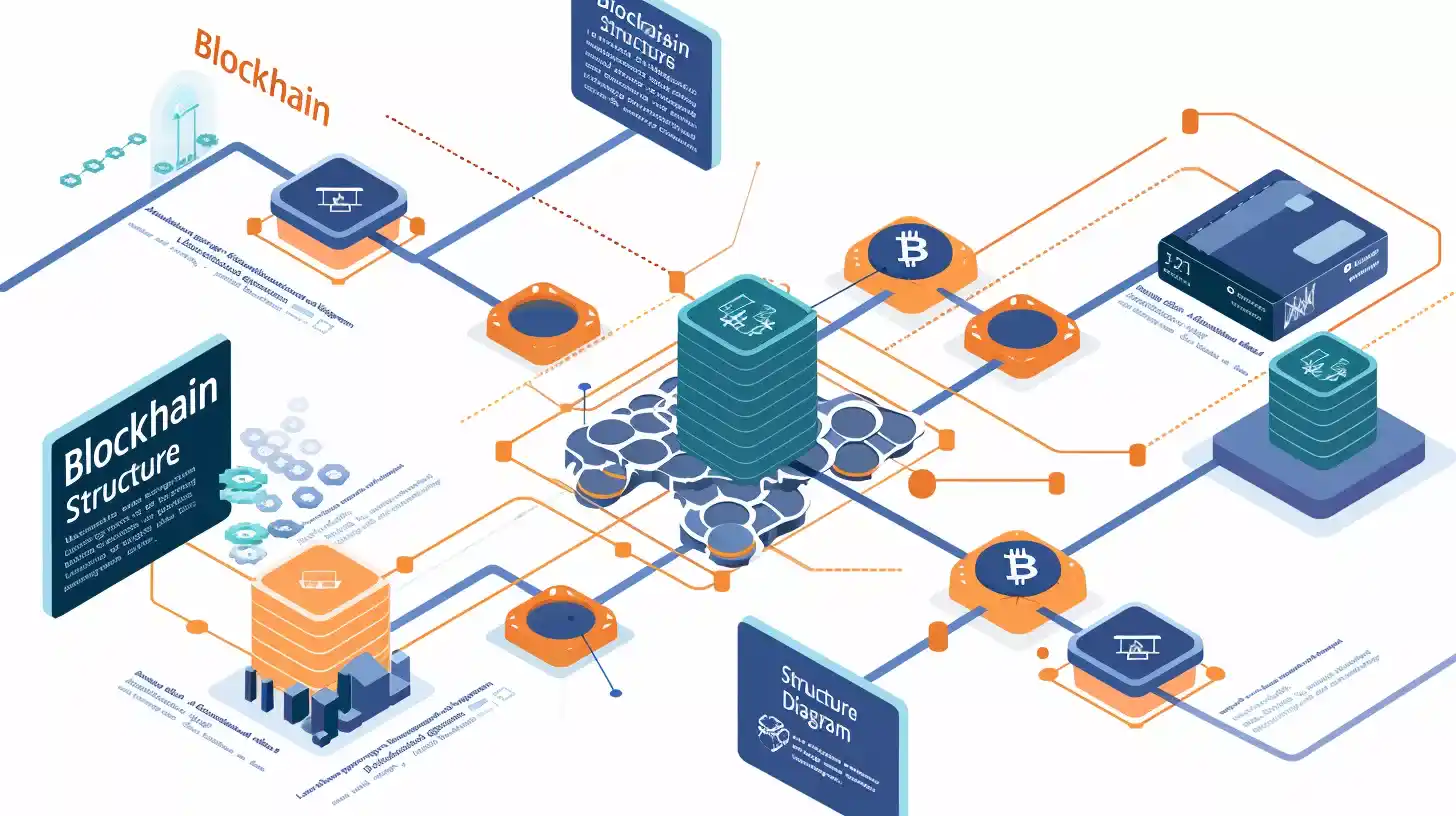Table of Contents
This comprehensive guide explores blockchain and its transformation
The blockchain technology has transformed the way businesses operate, bringing unprecedented transparency, security, and efficiency across various industries.
The term ‘blockchain’ is often surrounded by a whirlwind of hype and mystique.
As we move deeper into 2025, blockchain technology continues to mature beyond its origins in cryptocurrency, powering solutions in healthcare, supply chain management, financial services, and beyond.
What is it exactly, and why is it important?
This article peels back the layers of complexity to provide a clear, comprehensive understanding of blockchain technology, covering over 2000 words of explanation and exploration.
The Evolution of Blockchain: A Brief History
Blockchain’s journey began with the creation of Bitcoin in 2009, but its roots can be traced back to research and development efforts in cryptography and computer science over the preceding decades.
From a niche concept to a buzzword in tech circles, blockchain has come a long way.
Let’s explore its evolution and how it’s shaping our future.
What is Blockchain Technology?
Blockchain technology is an advanced database mechanism that enables transparent information sharing within business networks.
At its core, blockchain functions as a distributed digital ledger that records transactions across multiple computers in a way that makes the data nearly impossible to alter retroactively.
Additionally, blockchain intelligence enhances this system by analyzing vast amounts of blockchain data, providing insights that can improve security, compliance, and operational efficiency.
Blockchain Simple Explanation
To understand blockchain in simple terms, imagine a shared notebook that multiple people can write in, but once something is written, it cannot be erased or changed.
Every entry is visible to all participants, and everyone has an identical copy of the notebook.
This creates a system where trust is built into the technology itself, rather than relying on a central authority.
Each transaction is grouped into blocks, which are then linked together forming a secure and transparent chain.
This structure guarantees data integrity and provides a tamper-proof record, making blockchain ideal for applications requiring security and transparency.
The Anatomy of a Block
Each block contains a collection of data, the hash of the block (a unique digital fingerprint), and the hash of the previous block, creating a link.
The data in a block can vary from transaction details in a cryptocurrency to votes in an election, making it versatile for various applications.

How Blocks Are Chained
The magic of blockchain lies in how these blocks are chained together.
When a block’s data is entered, it’s sealed with its unique hash.
If the data is altered, the hash changes, signaling a breach in the chain.
This mechanism ensures a high level of security in blockchain.
How Blockchain Works
- The Process of Adding Transactions: When a transaction occurs, it’s broadcast to a network of computers, known as nodes. These nodes validate the transaction using known algorithms, a process that can involve solving complex mathematical problems in the case of cryptocurrencies.
- Verification and Consensus Mechanisms: Once a transaction is verified, it’s combined with other transactions to create a new block. This block is then added to the existing blockchain, but only after a consensus is reached among the nodes. This consensus mechanism ensures that each copy of the distributed ledger is the same, maintaining the integrity of the blockchain.
- Decentralization in Action: Decentralization is the heart of blockchain. Unlike traditional systems where a central authority has control, blockchain distributes control across the network. This not only enhances security but also democratizes data and trust.
Where is Blockchain Used in Real Life?
Here are some blockchain technology use cases.
Cryptocurrencies
Bitcoin, the first and most well-known cryptocurrency, is blockchain’s first successful application.
It demonstrated how money could be securely and anonymously transferred without the need for a central authority.
Similarly, Litecoin has gained popularity as a faster alternative to Bitcoin, and converting LTC to USD has become increasingly convenient through various online platforms and some of the Best Cryptocurrency Wallets, allowing users to easily manage their digital assets.
Beyond Bitcoin
Today, blockchain’s potential extends far beyond cryptocurrencies.
It’s being explored for supply chain management, voting systems, healthcare records, and even intellectual property rights, showcasing its versatility.
For instance, understanding the Bitcoin kurssi that discusses the Bitcoin rate can provide valuable insights into the broader economic implications of blockchain technology.
Blockchain for Social Good
Blockchain also holds promise for social impact, such as in humanitarian aid, where it can ensure transparency and traceability of funds, or in renewable energy, where it can facilitate peer-to-peer energy trading.
Financial Services
Banks and financial institutions use blockchain for cross-border payments, reducing transaction times from days to minutes while cutting costs significantly.
Ripple continues to expand its network, offering streamlined alternatives to conventional international payment methods.
Supply Chain Management
Blockchain enables seamless data exchange across networks, supporting real-life adoption by acting as a bridge between blockchain infrastructure and off-chain environments.
Companies track products from manufacturing to delivery, ensuring authenticity and reducing counterfeiting.
Healthcare Records
Blockchain’s ability to keep an incorruptible, decentralized, and transparent log of all patient data makes it ideal for security applications.
Medical institutions leverage this technology to securely share patient records while maintaining privacy.
Digital Identity
Blockchain provides secure, self-sovereign identity solutions where individuals control their own credentials without relying on centralized authorities.
Smart Contracts
These self-executing contracts automatically enforce agreements when predetermined conditions are met, eliminating intermediaries in legal and business transactions.

Some real-world examples of Blockchain Technology
- Money Transfer: Blockchain enables faster and more secure money transfers, often with lower fees compared to traditional banking systems. Companies like JPMorgan Chase have developed blockchain initiatives like Onyx for real-time settlement of interbank transactions.
- Smart Contracts: Smart Contracts are contracts written into code that automatically enforce and execute agreements. They are used in industries like real estate and legal services.
- Internet of Things (IoT): Blockchain can secure the vast amount of data generated by IoT devices, ensuring reliable and tamper-proof networks.
- Personal Identity Security: Blockchain provides a secure and unforgeable way of managing digital identities, which is crucial in the fight against identity theft and fraud.
- Healthcare: Patient records and medical data can be stored on blockchain networks, allowing for secure and immutable records that can be quickly accessed by authorized personnel.
- Logistics: Supply chain management is greatly enhanced by blockchain, as it provides real-time tracking of goods and verification of authenticity.
- Non-fungible Tokens (NFTs): These digital assets represent ownership or proof of authenticity of a unique item or piece of content, primarily used in digital art, collectibles, and gaming.
- Government: Blockchain Technology can streamline government operations, reduce corruption, and increase transparency by securely storing public records and facilitating voting systems.
What are the 4 Types of Blockchain Technology?
There are four main types of blockchain technology: public, private, hybrid, and consortium.
1. Public Blockchain
Public blockchains are permissionless networks where anyone with internet access can join and participate.
Bitcoin and Ethereum are prime examples.
These networks offer maximum transparency and decentralization, though they can face scalability challenges.
2. Private Blockchain
Private blockchains restrict access to authorized participants only.
These are ideal for enterprises that need blockchain benefits while maintaining control over who can view and validate transactions.
Private blockchains offer enhanced privacy and faster transaction speeds.
3. Consortium Blockchain
Consortium blockchains are governed by a group of organizations rather than a single entity.
This type is particularly useful in industries where multiple organizations need to collaborate while maintaining some level of decentralization.
4. Hybrid Blockchain
Hybrid blockchains combine elements of both public and private blockchains, allowing organizations to set up both permissioned and permissionless systems.
This flexibility makes them suitable for businesses that need both transparency and privacy.
Challenges and Misconceptions
- Debunking Common Blockchain Technology Myths: There are many myths surrounding blockchain, such as it being only for cryptocurrencies or that it’s inherently unbreakable.
This section will dispel these myths and present a balanced view of blockchain’s capabilities and limitations. - Security Concerns and Solutions: While blockchain technology is more secure than traditional record-keeping systems, it’s not immune to attacks.
We’ll explore the security concerns associated with blockchain and the measures taken to mitigate them. - The Scalability Debate: Blockchain’s scalability is a hot topic.
Can it handle the vast number of transactions required by global systems?
We’ll delve into the debate and examine potential solutions.

Blockchain and Crypto: Understanding Blockchain Encryption
Blockchain encryption is fundamental to blockchain security.
Strong cryptography is paramount to securing transactions on a blockchain network, helping secure assets from unauthorized access and transfer while ensuring user privacy.
Blockchain uses advanced cryptographic techniques, including:
- Public-key cryptography: Users have public keys for receiving assets and private keys for accessing them
- Hash functions: Convert transaction data into fixed-length strings that are nearly impossible to reverse-engineer
Digital signatures: Prove authenticity and prevent tampering
Blockchain Applications in Healthcare
The healthcare industry represents one of the most promising applications for blockchain technology.
Applications of blockchain in healthcare continue to expand, addressing critical challenges in the sector.
Key Healthcare Use Cases
Electronic Health Records (EHR) A blockchain network is used in healthcare to preserve and exchange patient data through hospitals, diagnostic laboratories, pharmacy firms, and physicians.
This ensures data integrity while maintaining patient privacy.
Drug Supply Chain Management Blockchain-based systems can record every level of the drug supply chain, making it easier to identify and remove fake drugs while monitoring drug life cycles.
Clinical Trials Blockchain plays a decisive part in handling deception in clinical trials, offering potential to improve data efficiency for healthcare and avoid the fear of data manipulation.
Medical Credentials Verification Blockchain provides secure, instant verification of healthcare professionals’ qualifications, licenses, and certifications.
Remote Patient Monitoring Blockchain technology is crucial for the storage, exchange, and retrieval of remotely gathered health data from mobile devices, wireless body sensors, and IoT devices.
Blockchain in Web Development: The Web3.0 Developer Era
The emergence of Web3 represents the next evolution of the internet, where blockchain technology forms the foundation for decentralized applications and services.
What is a Web3.0 Developer?
A Web3 developer is a software developer who specializes in building decentralized apps using the latest technology, needing a strong understanding of blockchain technology, distributed technology, and cryptography.
Key Skills for Blockchain Developers
Technical Foundation
- Proficiency in Solidity and smart contract development
- Understanding of blockchain protocols (Ethereum, Hyperledger, etc.)
- Knowledge of cryptography and distributed systems
- Experience with Web3.js or ethers.js libraries
Development Tools
- Truffle Framework for development and testing
- Hardhat for smart contract deployment
- MetaMask for blockchain interactions
- IPFS for decentralized storage
Career Opportunities
Blockchain development roles include positions as Blockchain Developer, Web3 Developer, and Smart Contract Developer, with the industry offering competitive salaries averaging around $140,000 annually.
The Future of Blockchain Technology
According to Statista, blockchain technology is forecast to grow by nearly 1 trillion US dollars by 2032, with a compound annual growth rate of 56.1% since 2021.
As blockchain matures, new trends are emerging, such as the integration of artificial intelligence and the rise of decentralized finance (DeFi).
These developments are setting the stage for the next wave of innovation.
Emerging Trends
Enterprise Adoption More organizations are moving beyond pilot projects to full-scale blockchain implementations across their operations.
Blockchain and AI Integration Companies like HyScaler are pioneering the combination of blockchain and artificial intelligence to create more intelligent, automated, and secure systems.
Regulatory Clarity As governments worldwide develop clearer frameworks for blockchain and cryptocurrencies, institutional adoption accelerates.
Sustainability Focus: New consensus mechanisms like Proof of Stake are making blockchain more environmentally sustainable.
Blockchain’s Potential Impact on Various Industries
Blockchain is poised to disrupt industries far and wide, from finance to law, and beyond.
We’ll investigate how blockchain technology could change the landscape of various sectors.
Preparing for a Blockchain-Driven Future
The blockchain revolution is just beginning.
This section will provide insights on how individuals and businesses can prepare for a future shaped by blockchain technology:
- Individuals: Stay informed about the evolving landscape of blockchain applications.
Explore possible job prospects in this expanding industry.
Consider how blockchain technology can empower you in areas like identity management, secure data storage, and participation in decentralized marketplaces. - Businesses: Identify potential use cases for blockchain technology within your industry.
Evaluate the impact of blockchain on your existing processes and explore opportunities for innovation.
Invest in pilot projects to test the feasibility of blockchain integration.
Build expertise within your workforce to navigate the technical aspects of blockchain.
Understanding Blockchain: Key Takeaways
To fully understand blockchain, recognize that it’s more than just a technology, it’s a paradigm shift in how we approach data, trust, and transactions:
- Decentralization removes single points of failure and control
- Immutability ensures data integrity and audit trails
- Transparency builds trust through verifiable records
- Security through cryptographic protection and consensus mechanisms
Efficiency by eliminating intermediaries and automating processes
Conclusion
The blockchain technology in 2025 is characterized by mature technology, diverse applications, and growing mainstream adoption.
From financial services to healthcare, supply chain management to digital identity, blockchain companies are delivering real-world solutions that transform how businesses operate.
Whether you’re looking for blockchain software development services, seeking to understand blockchain technology, or planning to hire a blockchain developer, the companies listed here represent the industry’s best.
Organizations like HyScaler, with their comprehensive blockchain as a service offerings and proven expertise, stand ready to help businesses navigate their blockchain journey.
As blockchain tech continues to evolve, staying informed about top blockchain development companies and emerging applications will be crucial for businesses seeking competitive advantages through this transformative technology.
FAQ
How does blockchain ensure security?
Blockchain utilizes cryptography to form an unchangeable ledger.
Every block is connected to the one before it, making any data tampering easily noticeable. Moreover, the decentralized structure of blockchain removes the possibility of a single weak spot
Can blockchain be used beyond financial transactions?
Definitely! Blockchain technology can transform numerous sectors.
It can be applied for safe data storage, managing supply chains, enhancing voting systems, protecting intellectual property rights, and more.
What are the limitations of blockchain?
Blockchain technology currently faces the challenge of scalability.
Handling a high number of transactions can be time-consuming and costly.
Moreover, the technology is relatively new, and its legal and regulatory frameworks are still developing.
How can individuals prepare for the blockchain revolution?
Stay curious and learn about blockchain! Explore online resources, attend workshops, and engage with the blockchain community.
Consider how this technology could impact your career path and explore potential opportunities in this growing field.
Is blockchain 100% safe?
No technology is 100% safe, and blockchain is no exception.
Although blockchain is considered one of the most secure transactional systems available, hackers have become skilled at exploiting vulnerabilities within blockchains and the electronic devices we use to connect with them.
However, blockchain’s security comes from multiple layers:
Cryptographic encryption protects transaction data
Distributed nature prevents single points of failure
Consensus mechanisms validate transactions
Immutability makes tampering detectable
Blockchain network security is the foundation on which its entire infrastructure rests.
If it’s strong, users will feel safe trusting their assets to it.
The main security considerations include:
User responsibility: Managing private keys securely
Smart contract vulnerabilities: Code must be thoroughly audited
51% attacks: Possible on smaller networks with less computing power
Phishing and social engineering: Targeting blockchain users
Who controls Bitcoin?
Bitcoin operates as a decentralized, distributed digital ledger where any involved block cannot be altered retroactively without altering all subsequent blocks, managed autonomously using a peer-to-peer network.
The short answer: No one controls Bitcoin.
Bitcoin’s decentralized nature means:
No central authority: Unlike traditional currencies controlled by governments or central banks, Bitcoin has no single controlling entity
Network consensus: Changes to Bitcoin require agreement from the majority of the network
Open-source code: Anyone can review, propose changes, or create their own version
Miners and nodes: These participants validate transactions but don’t control the network
Community governance: Major decisions involve developers, miners, users, and businesses
Who influences Bitcoin?
Bitcoin Core developers: Maintain the reference implementation, but can’t force changes
Miners: Process transactions and secure the network
Node operators: Enforce the rules by running Bitcoin software
Users: Ultimately decide which version of Bitcoin to use
This decentralization is fundamental to Bitcoin’s value proposition.
No government, company, or individual can manipulate it unilaterally.